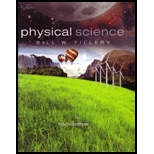
Concept explainers
A sandstone building stone measuring 50.0 cm long by 20.5 cm wide by 15 cm thick is 70 percent quartz with the rest of its volume being empty pore space. Based on the specific gravity of quartz determined in exercise 3, what is the mass of this building stone in kg? What would be its mass if it were quartzite? (Recrystallization of metamorphism eliminates the pore space.)
The mass of building stone in kg and mass of the Quartzite, if sandstone building measuring is
Answer to Problem 14PEB
Solution:
Explanation of Solution
Given data:
Length of the sandstone building is
Width of the sandstone building is
Height of the sandstone building is
Quartz of the sandstone building percent is
Formula used:
Write the formula for density
Here,
Write the formula for volume and multiply by the percentage that is quartz:
Here,
Explanation:
For sandstone:
Convert length m to cm.
Convert width m to cm.
Recall the formula for density
Rearrange:
Recall the formula for volume and multiply by the percentage, i.e., quartz:
Substitute
Substitute
Convert mass g to kg.
For Quartzite:
Substitute
Convert mass g to kg.
Conclusion:
The mass of building stone in kg is
Want to see more full solutions like this?
Chapter 17 Solutions
Physical Science
Additional Science Textbook Solutions
Loose Leaf For Explorations: Introduction To Astronomy
The Cosmic Perspective
College Physics
Conceptual Integrated Science
University Physics with Modern Physics (14th Edition)
Essential University Physics: Volume 2 (3rd Edition)
- An element makes up 0.0021% of the Earth's continental crust by mass. Express this in ppm (parts per million), to an appropriate number of significant figuresarrow_forwardWhat is the shape of thr T vs. 1/n^2 graph? What does this imply?arrow_forward250 200 150 100 50 10 20 30 40 50 VOLUME (cm') While doing laboratory work on density, a group of students collected data on the mineral pyrite. Their final graph is shown above. If a sample of pyrite has a volume of 50 cm3, what would its mass be? 250 g 175 g 200 g 10 g MASS (grams)arrow_forward
- A seismic survey is conducted in a region with two layers. The top layer is shale, with density 2500 kg/m3, and seismic velocity of 2900m/s, and the bottom layer is sandstone, with a density of 2100 kg/m3, and a seismic velocity of 3000m/s. The reflection coefficient will bea. Positiveb. Negativec. Zerod. Not enough informationarrow_forwardYou have a different rock with a volume of 30cm³ and a mass of 60g. What is its density?arrow_forwardA specimen of shale has a mass of 17.25 g dry and 22.24 g wet. The volume of the specimen is 12.15 cm3. What is the porosity of the shale?arrow_forward
- Earth's surface area is 5.10x10^8 km^2 .Earth's crust has a thickness (or depth) of 35 km and density 2.8 g/cm^3 for earth's crust. d) Silicon's concentration in earth's crust is 2.72x105grams/ton. Calculate the mass of silicon (in grams) present in earth's crust.arrow_forward(1.13 The resistivity of a water-bearing sand was found to be 0.4 -m. If the formation water resistivity is 0.02 N.m, give your best estimate of the formation porosity. What is the statisti- cally possible range of porosity in this sand? o ntn the rela.arrow_forwardGiven the density of iron as 7800 kg/m 3 , and the Earth radius is 6.38 x 10 6 m, if 55% of the Earth's volume is filled with Iron, and 45% is filled with rocks that has a density of 2600 kg/m 3 , what is the total mass of the Earth? I am looking for the total mass. m=densityxvolume, but am confused as im not such if i take 55% of irons density and 45% of the rocks density?arrow_forward
- Find the slope (pitch) of a perfectly smooth rock formation that rises 36.1feet vertically over a horizontal distance of 180.5 feet. What is the slope?arrow_forwardExplorers in the jungle find an ancient monument in the shape of a large isosceles triangle as shown in the figure below. The monument is made from tens of thousands of small stone blocks of density3 633kg/m3. The monument is16.7m high and68.5m wide at its base and is everywhere3.70m thick from front to back. Before the monument was built many years ago, all the stone blocks lay on the ground. How much work did laborers do on the blocks to put them in position while building the entire monument?Note: The gravitational potential energy of an object-Earth system is given byUg=MgyCM, whereMis the total mass of the object andyCMis the elevation of its center of mass above the chosen reference level.Jarrow_forwardPeak A has a height of 93 mm and a width at half height of 12 while peak B has a height of 79 and a width at half height of 7. What is the percent composition of peak B? Please give your answer as a whole number and do not include "%".arrow_forward
 College PhysicsPhysicsISBN:9781305952300Author:Raymond A. Serway, Chris VuillePublisher:Cengage Learning
College PhysicsPhysicsISBN:9781305952300Author:Raymond A. Serway, Chris VuillePublisher:Cengage Learning University Physics (14th Edition)PhysicsISBN:9780133969290Author:Hugh D. Young, Roger A. FreedmanPublisher:PEARSON
University Physics (14th Edition)PhysicsISBN:9780133969290Author:Hugh D. Young, Roger A. FreedmanPublisher:PEARSON Introduction To Quantum MechanicsPhysicsISBN:9781107189638Author:Griffiths, David J., Schroeter, Darrell F.Publisher:Cambridge University Press
Introduction To Quantum MechanicsPhysicsISBN:9781107189638Author:Griffiths, David J., Schroeter, Darrell F.Publisher:Cambridge University Press Physics for Scientists and EngineersPhysicsISBN:9781337553278Author:Raymond A. Serway, John W. JewettPublisher:Cengage Learning
Physics for Scientists and EngineersPhysicsISBN:9781337553278Author:Raymond A. Serway, John W. JewettPublisher:Cengage Learning Lecture- Tutorials for Introductory AstronomyPhysicsISBN:9780321820464Author:Edward E. Prather, Tim P. Slater, Jeff P. Adams, Gina BrissendenPublisher:Addison-Wesley
Lecture- Tutorials for Introductory AstronomyPhysicsISBN:9780321820464Author:Edward E. Prather, Tim P. Slater, Jeff P. Adams, Gina BrissendenPublisher:Addison-Wesley College Physics: A Strategic Approach (4th Editio...PhysicsISBN:9780134609034Author:Randall D. Knight (Professor Emeritus), Brian Jones, Stuart FieldPublisher:PEARSON
College Physics: A Strategic Approach (4th Editio...PhysicsISBN:9780134609034Author:Randall D. Knight (Professor Emeritus), Brian Jones, Stuart FieldPublisher:PEARSON





